
Engineering and Manufacturing for Biotechnology - Marcel Hofman & Philippe Thonart
.pdf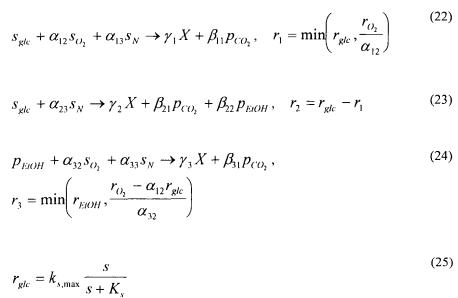
Teit Agger and Jens Nielsen
binding of regulatory proteins to genes by conventional equilibrium kinetics and describes in a highly mechanistic fashion the actions of positive and negative regulatory proteins on their own genes as well as structural genes. Other examples of element models is the modelling framework for protein glycosylation by Shelikoff et al. (1996) and the modelling of the penicillin pathway kinetics in Penicillin chrysogenum by
Pissara et al. (1996).
A somewhat different modelling approach, the so-called cybernetic modelling, was undertaken by Ramkrishna and co-workers (Dhurjati et al., 1985), based on the idea that cellular processes will function in a way that optimises the resulting outcome. This modelling concept aims at being used in cases where detailed information on regulatory processes is sparse and works by optimising an objective function rather than solving mass balances. Among its successful uses has been the description of microbial growth on multiple substrates (Ramakrishna et al., 1996).
4. Selected applications
An example of a very simple yet rather useful unstructured whole cell model, with the simplest possible segregation model and not containing any element models, is that of Sonnleitner and Käppeli (1986) who developed a model describing the growth of S. cerevisiae on glucose, as shown in eqs. (22) - (27). The model is based on an assumption of a limited respiratory capacity and includes oxidative and respirofermentative glucose metabolism [eq. (22) and (23), respectively] and oxidative ethanol metabolism [eq. (24)].
70
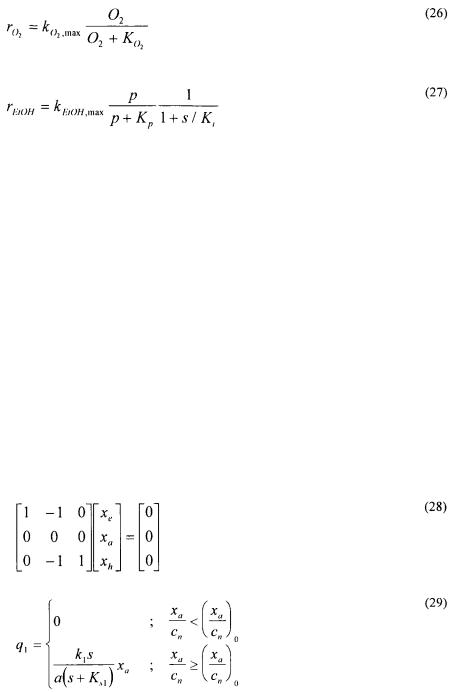
Mathematical Modelling of Microbial Processes
Despite its simple empirical structure, the model captures many essential growth characteristics such as the aerobic formation of ethanol at high glucose concentrations and the decrease in the oxidative capacity with decreasing oxygen concentration (the Pasteur effect). A model like this should be used for simulation of growth under relatively stable conditions as it will most likely fail if it is used to describe growth under dynamic operating conditions. This model has been refined a number of times since its first appearance, e.g. to include a description of overexpression of a homologous protein (Carlsen et al., 1997).
The growth of filamentous fungi pose a more difficult modelling objective as their growth pattern results in a continuum of cell types. Agger et al. (1998) approached the problem by using a morphologically structured model in which the hyphal elements are divided into three different regions: the extension zone (the very tips of the hyphal elements), the active region (responsible for all metabolic activity) and the inactive hyphal region. Two metamorphosis reactions are included in the model to describe formation of extension zones and hyphal cells from active cells [eq. (28)]. The whole cell model used to describe growth and substrate uptake is unstructured and uses kinetics based on models of fungal microscopic morphology; equations (29) - (31) give the volumetric rates of formation of the extension zone, the active region and the hyphal region, respectively. The values of almost all of the rather few model parameters can be determined from independent experiments and hence the model can be easily adapted to different fungal species by measuring the key morphological parameters.
71
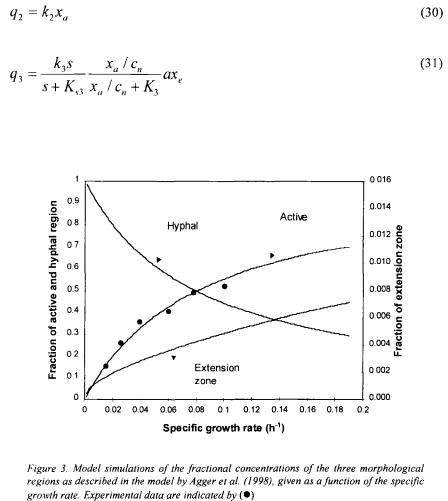
Teit Agger and Jens Nielsen
To validate the model structure, a combination of fluorescence microscopy and digital image analysis was applied. This method allowed a quantification of the active region of the cells, as shown in Figure 3.
Despite the simplicity of this model it performs rather well during simulations of dynamic growth conditions. This model, as well as that of Sonnleitner and Käppeli (1986), should be used for purposes where a relatively simple description of overall process performance is needed, but they can also be combined with element models if a detailed description of certain parts of the metabolism is required.
5. Future prospects
As illustrated with a few examples and discussed here mathematical models are very powerful tools in modern biology. However, as argued it is very important to define the
72
Mathematical Modelling of Microbial Processes
motivation for modelling, and there are roughly four different areas where mathematical models find useful applications:
• Teaching of quantitative aspects of biological systems.
•Design and control of biological processes, e.g. simulation and control of fed-batch fermentation processes.
•Extraction of quantitative information from experimental data.
•Integration of information about complex biological systems, e.g. complex regulatory networks as seen in some models for gene expression.
Traditionally mathematical models have been used in the two first areas, and there are also many examples where mathematical models have been applied for processing and comparison of experimental data. When it comes to integration of information about complex biological systems there are, however, only a few examples in the literature – best illustrated by the pioneering work of Lee and Bailey (1984a-c) who described gene transcription of the lac-operon in E. coli. In the future mathematical models will, however, play an increasingly important role in biological research for two reasons:
•There is an explosive increase in the amount of experimental data available, and novel analytical techniques offer the possibility to study individual cellular
processes at a level of detail not previously possible.
•The increase in computer power allows for simulation of even very complex mathematical models, and much more information can therefore be included in future models compared with the past.
In order to integrate the wealth of information supplied by advanced experimental studies of cellular function it is necessary to apply mathematical models that in a quantitative fashion allows for an evaluation of the importance of the individual cellular processes. Mathematical models offer the possibility to apply a whole cell view, or a systems approach, in the analysis of experimental data. For this reason they will become essential when information ranging from genomic research to advanced bioimaging is to be evaluated and interpreted.
References
Agger, T., Spohr, A. B., Carlsen, M. and Nielsen, J. (1998) Growth and Product Formation of Aspergillus oryzae during Submerged Cultivations: Verification of a Morphologically Structured Model Using
Fluorescent Probes, Biotechnol. Bioeng. 57: 321-329.
Agger, T. and Nielsen, J. (1999) Genetically Structured Modelling of Protein Production in Filamentous Fungi, Biotechnol Bioeng., 66: 164-170.
Carlsen M., Jochumsen K.V., Emborg C. and Nielsen, J. (1997) Modelling the growth and proteinase a production in continuous cultures of recombinant Saccharomyces cerevisiae, Biotechnol. Bioeng. 55: 447-454.
Dhurjati, P., Ramkrishna, D., Flickinger, M. C. and Tsao, G. T. (1985) A Cybernetic View of Microbial Growth: Modelling Cells as Optimal Strategists, Biotechnol. Bioeng. 27: 1-9.
Fredrickson, A. G., McGee, R. D. III and Tsuchiya, H. M (1970) Mathematical Models in Fermentation Processes, Adv. Appl. Microbiol., 23, 419.
73
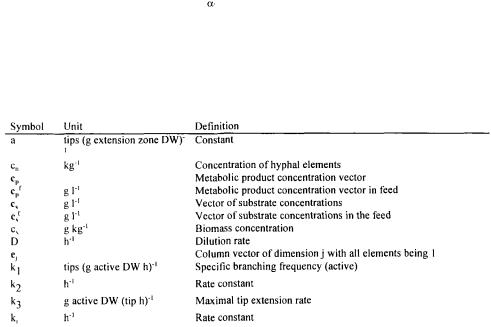
Teit Agger and Jens Nielsen
Lee, S. B. and Bailey, J. E. (1984a) Analysis of Growth Rate Effects on Productivity of Recombinant
Escherichia coli Populations Using Molecular Mechanism Models. Biotechnol. Bioeng. 26: 66-73.
Lee, S. B. and Bailey, J. E. (1984b) Genetically Structured Models for lac Promoter-Operator Function in the Escherichia coli Chromosome and in Multicopy Plasmids: lac Operator Function. Biotechnol. Bioeng. 26: 1372-1382.
Lee, S. B. and Bailey, J. E. (1984c) Genetically Structured Models for lac Promoter-Operator Function in the Chromosome and in Multicopy Plasmids: lac Promoter Function. Biotechnol. Bioeng. 26: 1383-1389.
Mathieu, M. and Felenbok, B. (1994) The Aspergillus nidulans CreA protein mediates glucose repression of the ethanol regulon at various levels through competition with the ALCR-specific transactivator. EMBO
J. 13: 4022-4027.
Nielsen, J. and Villadsen J (1992) Modelling of Microbial Kinetics, Chem. Eng. Sci., 47 (17/18), 4225-4270.
Panozzo, C., Cornillot, E. and Felenbok, B. (1998) The CreA Represser Is the Sole DNA-binding Protein Responsible for Carbon Catabolite Repression of the alcA Gene in Aspergillus nidulans via Its Binding to a Couple of Specific Sites. J. Biol. Chem., 273 (11), 6367-6372.
Pedersen, H.. Carlsen, M. and Nielsen, J. (1999) Identification of enzymes and quantification of metabolic fluxes in the wild type and in a recombinant Aspergillus oryzae strain. Appl. Environ. Microbiol., 65, 11-19
Pissara, P.D., Nielsen, J. and Bazin, M.J. (1996) Pathway kinetics and metabolic control analysis of a high- yielding strain of Penicillium chrysogenum during fedbatch cultivations, Biotechnol. Bioeng. 51, 168176.
Ramakrishna, R., Ramkrishna, D. and Konopka, A.E. (1996) Cybernetic modelling of growth in mixed, substitutable substrate environments: Preferential and simultaneous utilisation. Biotechnol. Bioeng. 52,
141-151.
Ramkrishna, D. (1979) Statistical models for cell populations, Adv. Biochem. Eng. 11, 1-48.
Sauer, U., Hatzimanikatis, V., Bailey, J.E., Hochuli, M., Szyperski, T. and Wuthrich, K. (1997) Metabolic fluxes in riboflavin-producing Bacillus subtilis, Nature Biotechnol., 15, 448-452.
Shelikoff, M., Sinskey, A. J. and Stephanopoulos, G. (1996) A Modelling Framework for the Study of Protein Glycosylation, Biotechnol. Bioeng. 50, 73-90.
Sonnleitner, B. and Käppeli, O. (1986) Growth of Saccharomyces cerevisiae is controlled by its limited respiratory capacity: formulation and verification of a hypothesis, Biotechnol. Bioeng. 28, 927-937.
Spohr, A., Carlsen, M., Nielsen, J. and Villadsen, J. (1997) Morphological characterisation of recombinant strains of Aspergillus oryzae producing -amylase during batch cultivations, Biotechnol. Let. 19, 257261.
Nomenclature
74
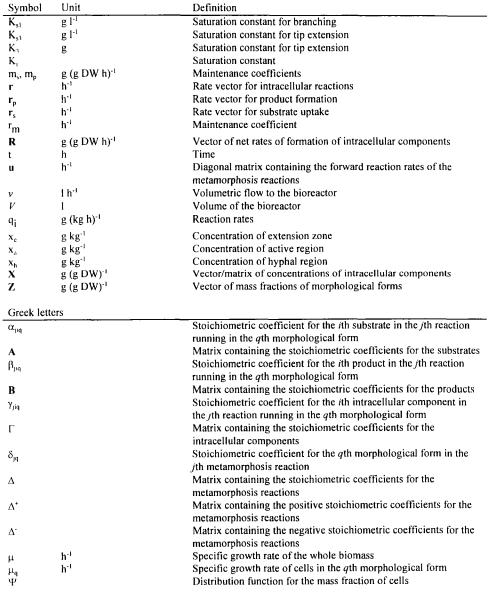
Mathematical Modelling of Microbial Processes
Nomenclature
75
MACROSCOPIC MODELLING OF BIOPROCESSES WITH A VIEW TO ENGINEERING APPLICATIONS
PH. BOGAERTS AND R. HANUS
Control Engineering and System Analysis Department
Université Libre de Bruxelles
Av. F.-D. Roosevelt, 50 C.P.165/55 B-1050 Brussels (Belgium)
Tel. 32-2-650.26.75 Fax. 32-2-650.26.77
E-mail: pbogaert@labauto.ulb.ac.be
Abstract
Several motivations exist to use macroscopic models for engineering applications and to define a general modelling methodology. In this context, the framework of system of mass balances based on macroscopic reaction schemes is recalled and a new general kinetic model structure is presented and analysed. A general methodology for the parameter identification (kinetic and pseudo-stoichiometric coefficients) is summarised.
Necessary conditions of validation of the reaction scheme (based on the identified model parameters) are proposed. The flexibility of the general kinetic model structure and a part of the parameter identification methodology are illustrated on simulated bacteria cultures.
1. Introduction
Engineering applications in biotechnology are concerned with the synthesis of several useful tools for monitoring cell cultures in bioreactors. Among these tools, simulators allow to reproduce the behaviour of cell cultures in bioreactors and this in a cheap and fast way in comparison with real experiments. These virtual experiments can be used to determine optimal experimental conditions (e.g., the dilution rate leading to a maximum amount of biomass in a given time), to train human operators before placing them in the real world, or to test other tools like controllers and software sensors. These latter consist of a second kind of engineering tool. They are able to replace some of the hardware sensors thanks to a combination of the remaining ones, a mathematical model of the bioprocess and a state estimation algorithm. Such a kind of software solution is particularly interesting in the field of bioprocesses where the hardware sensors often exhibit several drawbacks (cost, destruction of the samples, measurements only in
discrete time, time delay in the measurements, need for |
sterilisable materials, |
77 |
|
M. Hofman and P. Thonart (eds.). Engineering and Manufacturing for Biotechnology, |
77–109. |
© 2001 Kluwer Academic Publishers. Printed in the Netherlands. |
|
Ph. Bogaerts and R. Hanus
perturbation of the fluid dynamics, etc.). A third kind of engineering tool is made of controllers which pilot the bioreactors in order to respect the set points  temperature, dissolved oxygen, product concentration, ...) and to reject the disturbances acting on the process.
temperature, dissolved oxygen, product concentration, ...) and to reject the disturbances acting on the process.
For each of these engineering tools, it is necessary to build a model of the process.
The |
structure of this model (and especially its complexity) has to be adapted to the final |
|||
aim |
(simulation, |
state estimation, |
control). This |
means that, first of all, the model |
structure must be |
compatible with |
this aim. For |
instance, a software sensor must be |
|
based on a model which is observable, i.e. allows to reconstruct the state trajectory (e.g., all the concentrations, measured and non measured) in finite time on the basis of the available measured signals. Note that this definition of observability is just a heuristic one. In the same way, the model structure that will be used in a controller synthesis must involve the evolution of the signals to be controlled. Given a model structure that is supposed to be adapted to the final aim, a second critical point is the possibility to accurately identify the model parameters on the basis of experimental data. Too simple structures would not be able to reproduce the experimental data, whereas too complex structures could lead to overfitting if the number of experimenial dala is quite limiled.
Last but not least, it is interesting (at least from the economic point of view) that the model involves a number of measured signals which is quite limited. For example, if one is looking for a software sensor for the biomass concentration, a model involving the main substrate concentration, one product concentration and the biomass concentration will only require two hardware measurements (for the main substrate and for the product) whereas a detailed biological model involving numerous substrates and secondary metabolites would be much more requiring regarding the problem of the necessary hardware measurements.
The previous discussion shows that it is necessary to limit the complexity of the model structure and to limit the number of signals that have to be measured. Therefore, it is quite natural to consider the class of the unstructured and unsegregated models within the classification of Fredrickson (Tsuchiya et al., 1966; Tziampazis and Sambanis, 1994). A model is unstructured if the cell is considered as a unique lumped compartment (the biomass). A model is unsegregated if the cell population is considered as homogeneous (without distinctions based on the cell cycle, the cell size, etc.). In both cases, the structured and segregated features involve more state variables: several interior compartments and their component concentrations for structured models and several subpopulations of the biomass, depending on their position in the cell cycle, for segregated models. Structured models are based on the intracellular metabolism and often lead to the use of large amount of biochemical reactions (up to several hundreds). Techniques of simplification of the model are sometimes used (Barford et al., 1992). In many cases the model parameters are immediately deduced from the literature rather than identified on the basis of experimental data. Structured models have been used with bacteria and yeast cells (Roels, 1983), but also with animal cell cultures (Xie and
Wang, 1996a, 1996b) whose behaviour seems to be much more complex. Some authors have also combined structured and segregated features within a model (Martens et al.,
1995). Finally, segregated models are interested with the influence of the position within the cell cycle on the cell size (Nielsen et al., 1997) or on the production rate of
78
Macroscopic modelling of bioprocesses with a view to engineering applications
valuable components like monoclonal antibodies produced by hybridoma cells (Cazzador and Mariani, 1993).
The class of unstructured and unsegregated models which we are interested with consists of quite simple model in comparison with the above mentioned structured and/or segregated models. They are often used in engineering applications like state estimation (Bastin and Dochain, 1990; Gauthier et al., 1992; Ryckaert and Van Impe, 1996; Bogaerts, 1999b) or control of bioreactors (Bastin and Dochain, 1990; Bastin and
Van Impe, 1995; Van Impe and Bastin, 1995). This kind of model has generally been introduced within the framework of simple bacteria or yeast cell cultures, but their use has also been extended to the animal cell cultures (Glacken et al., 1988; Goergen et al., 1994). They mainly link the evolution of the biomass to the consumption of the main substrates and to the production of some metabolites and/or products of interest. Most of them are based on or inspired from the Monod law describing the specific growth rate (see Appendix 1 of the book by Bastin and Dochain (1990) ). The research in the field of the unstructured and unsegregated models is still ongoing (Zeng and Deckwer, 1995;Tan et al., 1996).
There is a large amount of model structures which are able to describe particular phenomena (like the limitation and/or the inhibition of the specific growth rate by the main substrate) and/or which are specific to particular applications (given cell lines within particular types of bioreactors). However, some authors have proposed more general mathematical modelling frameworks. Among them, the Biochemical System Theory was proposed by Savageau (1969a, 1969b). In this approach, the microorganisms are supposed to be composed by several components (structured model) whose overall production and consumption rates are given by power laws. These models are still used nowadays, for instance to determine the steady state for which the production rate of one (or several) product(s) of interest is maximised in microorganism cultures (Torres et al., 1996, 1997). Another general framework is given by the Metabolic Control Analysis (Westerhoff and Kell, 1987) which is based on a sensitivity analysis of the metabolic systems. This analysis is quantified by control coefficients and elasticity coefficients (Delgado et al., 1993). These coefficients are properties of the metabolic system (in steady state) and allow to determine the most sensitive steps of a reaction scheme. A third general framework consists in the cybernetic modelling developed by Ramkrishna and his co-workers (Dhurjati et al.,
1985) which was introduced to model the growth of microorganisms on multiple substrates. This approach considers the cells as optimal controllers that use the different available substrates so as to maximise a performance criterion (like the production of biomass). Finally, we also mention the general modelling methodology for animal cell cultures (Chotteau, 1995) which is based on the concept of macroscopic reaction network (Bastin and Dochain, 1990) and uses polynomial models for the overall consumption and/or production rates of the macroscopic species involved in the reaction scheme.
Although some general modelling frameworks exist and although the class of unstructured and unsegregated models corresponds to the appropriate level of mathematical complexity, several drawbacks are present in these approaches. They are discussed in the sequel and motivate the development of a new general kinetic model
79

Ph. Bogaerts and R. Hanus
structure. Moreover, there also exist some important lacks in the available parameter identification procedures. Therefore, a systematic parameter identification methodology is also proposed in this text.
In Section 2, the basic concept of macroscopic reaction network and its associated mass balances is recalled. Section 3 presents the main drawbacks of the above mentioned general frameworks and of the usual models belonging to the class of the unstructured and unsegregated models. This motivates the proposition of a new general kinetic model structure exhibiting several interesting properties. Section 4 motivates the proposition of a systematic methodology for the parameter identification of the model structure described in Sections 2 and 3. The methodology is described and necessary conditions for reaction scheme validation are provided. Section 5 illustrates the flexibility of the new kinetic model structure and a part of the identification methodology by applying these concepts on simulated bacteria cultures (based on several Monod-type laws for the specific growth rate of the simulator). Finally, Section 6 summarises the material and presents some recent developments and perspectives in this field.
2. Macroscopic reaction network and associated mass balances
As we have seen in the introduction, it is necessary to limit the complexity of the model structures to be used in engineering applications. It is therefore often sufficient (and sometimes necessary) to limit the description of the biological and chemical phenomena to a limited number of essential events. The latter may be contained within a macroscopic reaction network (Bastin and Dochain, 1990)
where
•M is the number of reactions;
• the
the  component;
component;
• the reaction rate;
the reaction rate;
• and
and  the pseudo-stoichiometric (or yield) coefficients (positive when
the pseudo-stoichiometric (or yield) coefficients (positive when
associated to a component which is produced, negative when it is consumed).
It is important to note that this kind of macroscopic reaction network does not respect the elementary mass balances (oxygen, carbon, ...) but quantifies the yields 
between the consumption and production of the macroscopic species  Typically,
Typically,
these networks contain between one and six reactions. Several examples are given in the book of Bastin and Dochain (1990). It is possible to distinguish three main types of reactions. The first one consists of the simple reaction, e.g.
80
